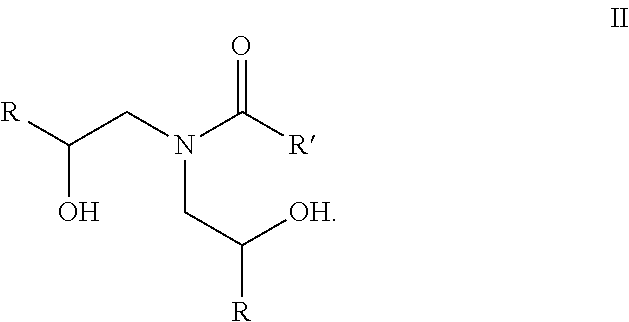Method for reducing engine wear with lubricants comprising 2-hydroxyalkylamide friction modifying / Anti-wear compositions
a technology of friction modification and composition, which is applied in the direction of lubricant composition, petroleum industry, additives, etc., can solve the problems of complex and interfering with dispersants, limiting the service life of catalytic converters used on cars, and ash indialkyldithiophosphates, etc., to achieve stable, storable oil formulations, and easy lubrication. oil soluble
- Summary
- Abstract
- Description
- Claims
- Application Information
AI Technical Summary
Benefits of technology
Problems solved by technology
Method used
Image
Examples
example 1
[0092]The methyl tallate esters from above, toluene solvent and catalytic sodium methoxide were heated to approximately 60° C. and a slight excess of bis-(2-hydroxypropylamine) was added. The resulting mixture was heated to about 120° C. and stirred for 4 hours to yield a mixture of bis-(2-hydroxypropylamine) fatty acid amides, predominately stearyl, oleic and palmitic amides plus smaller quantities of other amides corresponding to the tallow acid mixture above, as a clear, liquid / oil.
example 2c
[0093]Following the procedure of Example 1 and using di-ethanolamine in place of bis-(2-hydroxypropylamine), yielded a mixture of di-ethanolamine fatty acid amides, predominately stearyl, oleic and palmitic amides plus smaller quantities of other amides corresponding to the tallow acid mixture above, as a solid.
example 3c
[0094]Following the procedure of Example 1 and using methyl stearate in place of the methyl tallate esters yielded stearyl [bis-(2-hydroxypropyl)amide] as a waxy solid.
PUM
| Property | Measurement | Unit |
|---|---|---|
| temperatures | aaaaa | aaaaa |
| temperatures | aaaaa | aaaaa |
| kinematic viscosity | aaaaa | aaaaa |
Abstract
Description
Claims
Application Information
 Login to View More
Login to View More - R&D
- Intellectual Property
- Life Sciences
- Materials
- Tech Scout
- Unparalleled Data Quality
- Higher Quality Content
- 60% Fewer Hallucinations
Browse by: Latest US Patents, China's latest patents, Technical Efficacy Thesaurus, Application Domain, Technology Topic, Popular Technical Reports.
© 2025 PatSnap. All rights reserved.Legal|Privacy policy|Modern Slavery Act Transparency Statement|Sitemap|About US| Contact US: help@patsnap.com



